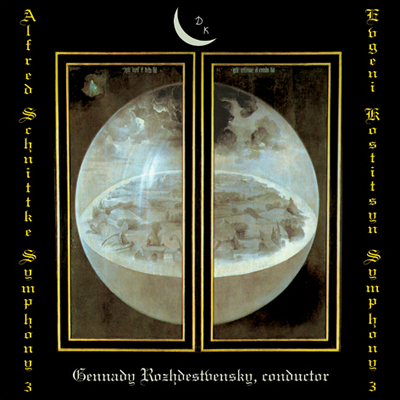Download
part of track

When you enter a room and hear classical music sounding you unconsciously realize its place in the entire work. Is it the cadenza, the exposition or the development? You know your body and know where each part should be. Legs usually don't grow from the head and we usually don't confuse the head with another part of the body. Everything bears a sign of
its place. We read these signs and evaluate them. This idea is fundamental for many compositions by Alfred Schnittke (1934 - 1998). When the next section of musical form is due - you may insert music of a different style and epoch. If it bears an appropriate 'sign of place' it will work!
Symphony No. 3 by Schnittke is a perfect example of exploiting the 'sign of place' idea. You may count over a dozen different styles used in this work. 'Sign of place' developed Schnittke's polystylism much earlier than Symphony No. 3 was composed and it affected musical forms much more than other elements of his musical language.
Schnittke's forms don't follow the classical standards. Instead they display a 'counterpoint of logical structures', which seems to be the most universal approach to the analysis of any style. 'A logical structure' means more than just musical material. The term also applies to emotions, illusions and ideas. In this case the same 'structures' - the same meaning - can be expressed by different musical means.
I realize how disappointing my theory is for the followers of monothematism. Reality displays the existence of many concepts of integrity different from theories by Aristotle and Beethoven.
Symphony No. 3 is one of the most monumental works by Schnittke. It was written on the occasion of the Leipzig "Gewandhaus"orchestra jubilee and opening of the new "Gewandhaus" concert hall. The premiere took place there on November 5, 1981, and was
conducted by Kurt Mazur with tremendous success. In the Soviet Union the Symphony was
first performed by the USSR Ministry of Culture Symphony Orchestra under Gennady
Rozhdestvensky in the autumn of 1982.
Gennady Rozhdestvensky, USSR People's Artist, Lenin Prize Winner, is an outstanding
musician of today. An artist of universal ideas and wide artistic interests, Rozhdestvensky
has paid tribute to the art of the 20th century and mostly to Russian music, works of his
contemporaries, from the very beginning of his career. He premiered and recorded many
symphonic compositions by Schnittke.
A new method of organization of musical material is represented in my own Symphony No. 3. I call it "synchronous music". Though synchronous music demonstrates a new artistic result, the idea of the simultaneous unfolding of two or more compositions is at least several centuries old. We can hear it in double and triple fugues by J.S.Bach, in "Marriage of Figaro"
by Mozart, in works by Charles Ives.
You may ask: "Is there any limit to the number of compositions that may be heard at the same time?" I would answer: "Yes. It is determined by the limit of our perception. Any detail, which cannot be distinguished and perceived is defective and demonstrates a lack of the composer's professionalism". Many would ask "How can I perceive this complex music?"
I would answer, that you don't need any help. Synchronous music would not survive if you would need any assistance.
No one can focus their attention on more than one thing at the same time. Always our perception follows only one major layer of musical texture. If the prioritized material switches from one layer to another our attention follows this change. So while listening to synchronous music your perception will bounce between different compositions sounding at the same
time and this shifting will evoke remarkable emotions and experiences. The same way you listen to fugues - your attention switches from one entrance of a theme to another. We unconsciously track these musical events. The 'tracking list' is remarkably rich and long in works written in the synchronous music style. Time and information are compressed.
I individualized the different works which make up the texture of Symphony No. 3 by different tempi, timbres, forms, often styles and used eight extra sub-conductors to lead the choir, different ensembles and groups inside the orchestra. Of course, there is always a principal conductor. He shapes the architecture of the entire work and interprets it.
The fact that synchronous music is no longer an experiment sets it apart from previous attempts made in this direction. Synchronous music is a new style which demonstrates a new method of organization of musical material. It applies to all elements of musical language and establishes a new tradition to compose, perform and listen. Synchronous music is perfect
to portray the versatile, polyphonic nature of the modern world. To create an all-embracing view is the fundamental idea of every composer writing symphonies.
Alfed Schnittke (1934 - 1998)
Symphony No. 3
1. Moderato - 13:55
2. Allegro - 12:45
3. Allegro Pesante - 8:04
4. Adagio - 18:47
Evgeni Kostitsyn (b. 1963)
Symphony No. 3
5. Symphony No. 3 -19:01
Total Time - 72:41
Alfred Schnittke. Symphony No. 3
The USSR Ministry of Culture Symphony Orchestra
Conductor - Gennady Rozhdestvensky
Recorded in 1984
Recording engineers:
Veprintsev and Buneyeva.
© 1990 Gramzapis
© 2002 CDK Music
Evgeni Kostitsyn. Symphony No.3
Kiev Philharmonic Symphony Orchestra
National Choir of the Ukraine "Dumka"
Choir Master - Victor Petrichenko
Conductor - Evgeni Kostitsyn
Recorded in 1997
Recording engineer - Vikharev
© 1997 Evgeni Kostitsyn
© 2002 CDK Music
cover painting - "The Garden of Earthly Delights" by Hieronymus Bosch